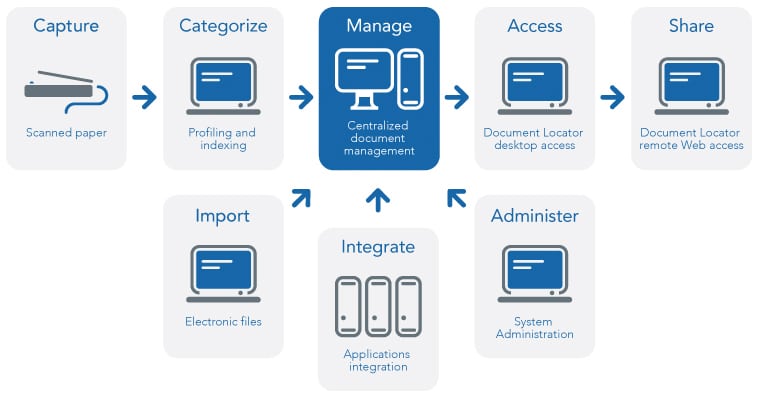3 Challenges of a Document Management System No One Will Tell You About

Document management is a challenge for every organization, but despite the headache, it’s an important part of conducting business.
A document management system is a strategy for collecting, storing, organizing, and retrieving documents vital to accounting firms, car washes, and toy manufacturers. No matter your industry or size, having the right document management system can be the difference between success and failure, but not without creating challenges.
It’s not all doom and gloom for businesses: anything worth doing is worth doing well, and despite the challenges of a document management system, there are best practices that can help mitigate these challenges and eliminate the headache of document management. This guide will explain the challenges that no one will tell you about document management and how you can overcome these challenges with the right approach to document management.
Key Takeaways:
- Paper and labor are significant expenses for most businesses.
- Sorting and accessing documents is challenging without document management software.
- Keeping documents secure is a challenge for every company
- Document management software from FileCenter can help you overcome document management challenges.
READ ALSO:
10 Best Document Management Software for Small Businesses in 2024
10 Best Document Scanning Software for Windows 10 Users in 2024
Paper and Storage Costs
An individual sheet of paper is only 0.1mm thick—the same thickness as a single strand of hair.
While 0.1mm may not seem like much because United States offices use over 12 trillion sheets of paper each year, those millimeters add up quickly: each office worker uses an average of 10,000 sheets of paper each year, enough to stack over 3 feet tall.
Creating, organizing, and storing all that paper costs money, but how much it costs you depends on how you use it. Paper documents can cost you in several ways:
- Storage Space. Filing cabinets can cost hundreds or thousands of dollars, but that is insignificant compared to the real estate they occupy. As real estate prices soar, the 17 square feet one filing cabinet occupies comes at a premium in an in-demand market like New York City, where office rent can cost over $100 a square foot. That adds up to $1,700 per year for each filing cabinet.
- Paper Costs. “Paper” is nearly synonymous with “disposable”—paper plates, paper towels, and paper hats are single-use and thrown away. Despite this frivolity, paper costs add up quickly, with the average company spending $8,000 each year on paper alone—to say nothing of printer and ink costs.
- Labor Budget. The average employee spends 3.6 hours each day looking for information, up to 4.2 hours daily for IT employees. Depending on your industry, you may spend over half of your labor costs on document management. That makes document management one of your company’s largest expenses.
- Burnout. All that time looking for documents is not only expensive, but it’s also frustrating. The inconvenience of locating documents is a major source of stress for employees—about one-third of employees said that being unable to find information leads to burnout, and 16% said it made them want to leave the company.
Information Access
The purpose of a document management system is to sort, store, and access information, but document management can cause additional stress and confusion when done improperly.
Estimates vary, but your company spends $20 in labor to file each document on average.
But that’s just for documents filed correctly—finding a misfiled document is like looking for a needle in a cabinet full of haystacks. Finding a misfiled document costs 5x as much as a correctly filed document, while reproducing a lost document costs 11x as much, or $220.
The biggest challenge of building a document management system is creating a strategy for consistently organizing documents so users can have accurate, timely access to information when needed. Many users have turned to document management software because it offers a digitally sortable and searchable document repository.

Security Challenges
Companies walk a fine line between creating convenient access to documents and restricting access. Employees must have easy access to the documents they need, but it’s equally vital that non-employees can’t access personal or confidential information.
Maintaining security is not as simple as drawing a line between employees and non-employees, though—different employees need access to different documents, and these categories can overlap. Accountants and bookkeepers need access to financial records, salespeople need access to CRM data, IT professionals need access to credentials like usernames and passwords, and executives need access to a cross-section of all this data.
Maintaining these complicated clearance levels falls between difficult and impossible in a traditional document management system. Balancing this access frequently results in siloed data between departments, multiplying paper and labor expenses as each document must have a physical copy when shared across departmental lines. Keeping a physical document room secure and organized is more than a full-time job.
Overcoming Document Management System Challenges
While these document management system challenges are difficult to overcome, they aren’t impossible. As technology progresses, new tools have made document management as affordable, efficient, and secure as possible.
Document management software is a digital replacement for a traditional document management system. Instead of organizing files in boxes and filing cabinets, document management software organizes files in a digital directory that mimics a physical system’s cabinet/drawer structure.
How does a digital system fix the challenges of document management systems?
Document management software reduces paper costs by encouraging paperless procedures and digital documentation. Perhaps the most significant cost savings, however, is the labor saved by document management software. This software stores digital files that can be sorted, edited, tagged with metadata, searched, and shared with the click of a button. It turns the time-consuming process of searching for documents into a simple query.
Not only is document management software more efficient and accurate than a physical system, but it’s also more secure, as only authorized users can access the system. Document management systems like FileCenter use a secure portal to share encrypted documents with external users without giving them access to the wider repository.

FileCenter Document Management Software
Document management is challenging, but it doesn’t have to be.
FileCenter’s document management software makes managing documents affordable, efficient, and secure. Whether you need to share documents with clients, convert PDFs to Excel spreadsheets, or access your documents from across the globe, FileCenter can help you overcome document management challenges.
To learn how FileCenter can revolutionize your document management system, download a free trial or schedule a demo today.


